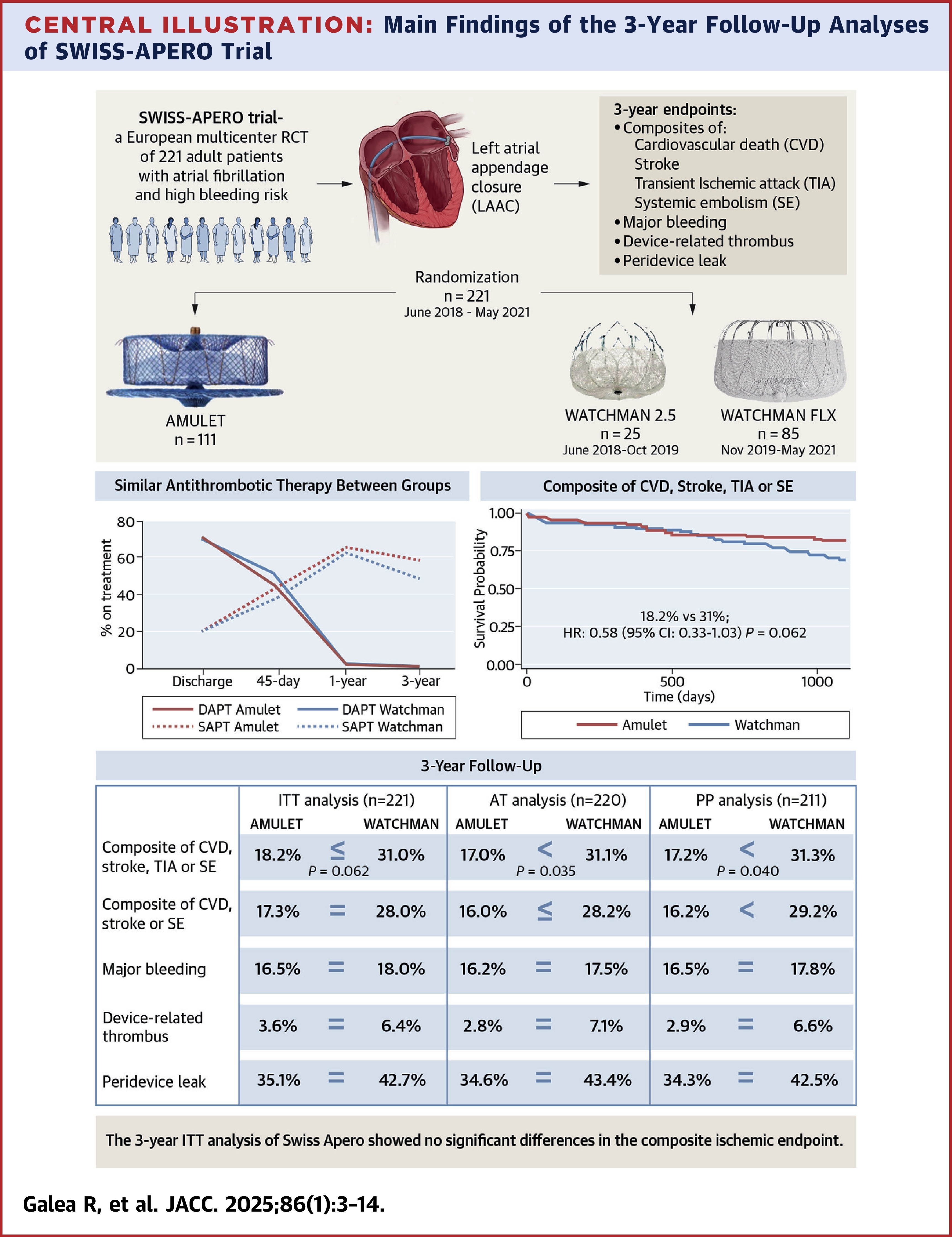SWISS-APERO: Similar 3-Year Ischemic Risk With Amulet vs. Watchman FLX
While there was no significant difference in ischemic risk in patients with atrial fibrillation between the Amulet and Watchman FLX devices at three years following left atrial appendage closure (LAAC), according to findings from the SWISS-APERO trial published in JACC, the authors note that in the as-treated (AT) and per-protocol (PP) analyses there was a hypothesis-generating lower occurrence of the composite ischemic endpoint (cardiovascular death, stroke, transient ischemic attack or systemic embolism) with the Amulet device.
In the investigator-initiated trial, Roberto Galea, MD, et al., randomized 221 patients (29% women; mean age 77 years) with atrial fibrillation and high bleeding risk (mean CHA2DS2-VASc score, 4.3; mean HAS-BLED score, 3.1) to receive either the Amulet (n=111) or Watchman/FLX (n=110) device while undergoing LAAC. Of the patients, 220 completed LAAC, and three patients in the Amulet arm received the Watchman FLX device instead. In the Watchman arm, 25 patients early in the trial received the Watchman 2.5 because the FLX was not yet available.
Results showed at three years that the composite ischemic endpoint occurred "numerically less frequently" in the overall comparison of the Amulet vs. the Watchman groups (18% vs. 31%; hazard ratio [HR], 0.58; p=0.06), as well as in the AT analysis (17% vs. 31%; HR, 0.53, p=0.035) and the PP analysis (16% vs. 29%; HR, 0.54; p=0.049).

Additionally, a subanalysis focused on late events (>7 days) following LAAC showed a significantly lower rate of ischemic outcomes in the Amulet arm. In the AT analysis, there was a significantly lower rate of the composite of cardiovascular death, stroke, transischemic attack or systemic embolism with the Amulet vs. Watchman FLX device (17.0% vs. 31.1%; HR, 0.53), driven by a significantly lower rate of cardiovascular death. Device-related complications and rates of peridevice leak did not significantly differ between the two arms, but both were numerically lower in the Amulet arm.
In an accompanying editorial comment, Godbless Ajenaghughrure, MD, and Emile G. Daoud, MD, emphasize the lack of statistically significant differences and note, "It seems that, to date, there is no compelling evidence that closes the debate of which LAAC device is superior."
They note the subanalysis of late events "shows a significantly lower event rate with Amulet as well as a novel finding, not reported by other trials, of a sharp increase in the slope of the [Watchman] group curve starting at the 13-month follow-up."
"There is no obvious explanation for this finding, but device imaging at the time of these late events may have helped identify if they were related to the device," they add.
Clinical Topics: Arrhythmias and Clinical EP, Atrial Fibrillation/Supraventricular Arrhythmias
Keywords: Atrial Fibrillation, Atrial Function, Left, Atrial Appendage, Stroke
< Back to Listings
